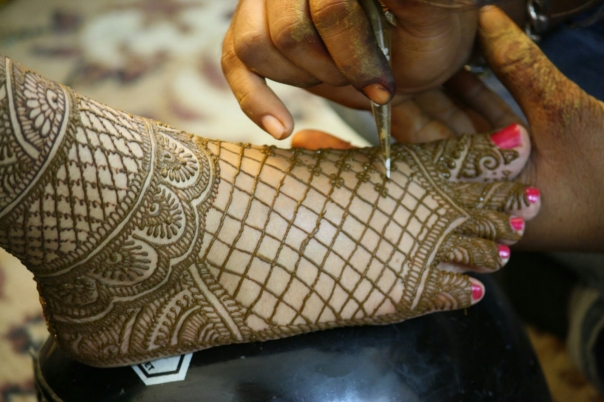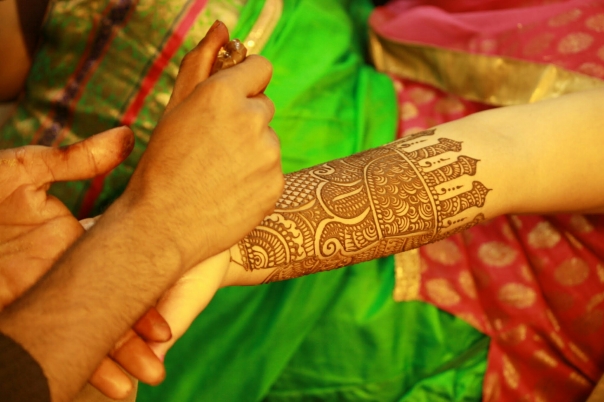So much has been shown and talked about the big fat chaotic Punjabi weddings. But I was fortunate to be a part of one which had such a warm, happy chaos about it!
This was one I was certainly never going to miss and God knows why! I suppose that’s why I am here. The bride is a dear friend of mine since the time we walked into our college days straight out of school. But this was the best opportunity to meet her entire family which could usually take about a year considering the number of uncles,aunts and cousins located in different parts of India. They were the liveliest and loveliest people I could have had an interaction with on my visit to Delhi after 14 long years. They were a loud and happy crowd who cracked a joke without ever meaning to, laughed without holding back and danced like no one was watching. For a typical South Indian coming from a community of introverts who get lost in crowds, I felt myself at home amongst thirty odd people whom I didn’t have to make an effort to introduce myself to. They took upon themselves to make me feel comfortable the minute they walked in.
The significance of customary rituals in weddings across the diverse regions of India are rather interesting to observe. A Punjabi wedding would ideally extend from 2-5 days depending upon how many events the families decide to have. This one was short and sweet and lasted for three meaningful days. The first day was the mehandi which happens at the bride’s home with her close family and friends. The mehandi artists are skilled and creative in the different designs they make with henna cones on the hands and legs of the bride followed by the rest of the bride’s entourage. In a day these artists may visit as many as six to seven houses during the wedding season and each home may have anywhere between 10-30 ladies whose hands have to be catered to! They usually move in pairs, so by a rough calculation, that’s close to 300 hands per artist! Mehandi is followed by the chooda (bangle) ceremony. The bangles are traditionally red and white in colour made of ivory or shell and the bride’s maternal uncle and aunt put the bangles on for the bride. The bride must have her eyes closed while the bangles are being put on her hands and they are then covered with a white cloth which she removes only on the day of the wedding. The significance of the chooda is the abundance of blessings she receives as a bride. Red symbolizes strengthening of the bond between the married couple and is a very important colour in most Indian weddings.
This is followed by the friends,cousins and sisters of the bride putting on the kalire (gold or silver jangles) for her. Kalire are worn with the chooda and symbolize the good wishes she receives from her friends and cousins whom she leaves behind in her maternal home. The kalire are shaken over the heads of unmarried girls and if any of it falls on their heads, they are believed to be next in line for marriage. It is quite similar to the throwing of the bridal bouquet in Christian weddings. The second day was the wedding in the temple followed by lunch and the events came to a grand closing with the wedding reception on the last day.
From the mehandi ceremony to dancing to the endless Bollywood scores, I was smitten by the complete culture shift we South Indians tend to miss out on. I think it’s some displaced emotion that constantly makes us search for comfort away from the maddening crowd. But sometimes the same maddening crowd brings out the freedom to be ourself! I watched fat ladies least bothered about their weight when they danced. I watched stylish ladies shed all their airs to perform before a crowd. And everyone clapped, laughed,ate, drank and remained merry. No one overshot the limits of respect due to the elders, no one acted boorish or threatened the dignity of another. And I was meeting them all for the first time…after having known my friend for 19 years! That’s a South Indian introvert for you!
There was a genuine joy that everyone in the room shared with the bride who of course was looking beautiful and ecstatic throughout. I suppose when you are single long enough, the appreciation towards marriage is greater.
The fact that she had the closest of family and friends around made it meaningful rather than inviting people to keep up with social standards which seems to be in trend these days.
The bride’s family were always ready to shake a leg at the sound of music and drum beats. I had a free run to move around and feed my shutterbug’s appetite through all the ceremonies. I witnessed an interesting and long drawn negotiation the groom was forced into in order to get back his wedding shoes after the wedding ceremony in the temple. The bride’s cousins had hidden them away and would only return them for a cost. I am sure it was the first time he had to pay a hefty five- figure sum for a pair of shoes that he had already purchased!
It was all a very new experience for me. I was amused, thrilled and happy all at the same time. And I’m excited about all that lies ahead. But the next time someone talks about a Punjabi wedding, I would have a thing or two to share, for nothing substitutes experience.


